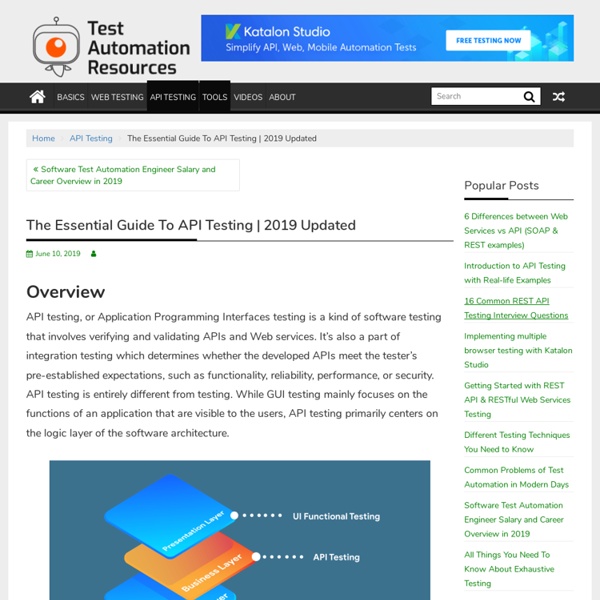What is End-to-End (E2E) Testing?
End-to-End Testing: What is it? End-to-end testing is a technique that tests the entire software product from beginning to end to ensure the application flow behaves as expected. It defines the product’s system dependencies and ensures all integrated pieces work together as expected. The main purpose of End-to-end (E2E) testing is to test from the end user’s experience by simulating the real user scenario and validating the system under test and its components for integration and data integrity. Software systems nowadays are complex and interconnected with numerous subsystems. If any of the subsystems fails, the whole software system could crash.
Katalon Studio
Does your business plan include a continuous testing strategy? Is continuous testing right for your organization? Every company who has implemented continuous testing had to answer these questions – and not all companies are able to do so. It requires a strategic planning process and many changes would need to be put in place, which can be challenging for small and large organizations alike.
Introduction to Continuous Testing
Customers nowadays expect top-notch software for their businesses or personal use. To accommodate that need, software companies are incorporating Continuous Testing practices to ensure the software they release to market can outshine the competition. What is Continuous Testing? Continuous Testing is a software testing type in which the product is evaluated early, often, and throughout the entire Continuous Delivery (CD) process.
What is CI/CD? Continuous Integration & Continuous Delivery
CI/CD is the acronym for the combined practices of Continuous Integration (CI) and Continuous Delivery (CD). CI/CD practices are currently the most widely accepted choice to shorten software development and delivery cycle time. In today’s ever-evolving landscape, one of the top challenges for software companies is quickly responding to market and customer demands.
Apply Shift-Left Testing Approach to Continuous Testing
As the demand to release quality software products in the short amount of time continues to accelerate, Agile and DevOps teams have to adopt new approaches to avoid falling behind. Continuous testing and shift-left testing are two breakthrough solutions in this modern era of software delivery. In this blog, we will walk you through these two notions, their benefits, and how to implement them into your software development life cycle (SDLC). What is Continuous Testing? Continuous testing uses a procedure of testing early and often throughout the development lifecycle. Incorporating continuous testing into your organization’s testing strategy accelerates your time-to-market but keeps (or even improves) the quality your customers expect.
Top 10 Benefits of Continuous Integration & Continuous Delivery
Continuous Integration (CI) allows you to continuously integrate code into a single shared and easy to access repository. Continuous Delivery (CD) allows you to take the code stored in the repository and continuously deliver it to production. CI/CD creates a fast and effective process of getting your product to market before your competition as well as releasing new features and bug fixes to keep your current customers happy. If you are new to CI/CD, check out the article: Complete Introduction to CI/CD In this blog, we’re going to delve into the top 10 Benefits of Continuous Integration and Continuous Delivery to help you decide if this is the right step for your organization to take. Top 10 Benefits of Continuous Integration and Continuous Delivery
What are Microservices? A Complete Introduction for Beginners
Microservices are a type of architectural style for building software that has been gaining popularity. The concept was first introduced at a tech conference in 2011 and has been adopted by many Agile enterprises such as Netflix, Amazon, Uber, SoundCloud, Groupon, eBay, to name a few. So, what are microservices? What are the benefits of microservices?
What to Consider Before Applying CI/CD
Continuous integration and continuous delivery (CI/CD) is a complex part of any development cycle. It involves continuously integrating code into a shared repository to keep code progression amongst a team of developers running smooth and steady. This helps prevent merging errors, duplicated efforts and promoting collaboration to create a better product. That code is then thoroughly and continuously tested to keep problems from arising. From there, the code is then deployed to production to be continuously delivered to the live environment.
Best Strategies to Implement for Your Team
In today’s rapidly changing world, software products need to be upgraded frequently and quickly to bring value to customers and users. Software features are continuously developed, tested, deployed, and operated in the production environment. New features are not only developed and tested successfully, but they also deployed and operated without much chaos and disruption. Software cross-functional teams which include product owners, software development, quality assurance (QA), operations need to work together to ensure the fast flow of work from development to operation. This requires development teams to be more productive in delivering quality work while QA, operations, and other teams need to use automated tools and follow well-formed practices to minimize their dependence on other teams. DevOps has been a process that organizations seek to achieve this goal.
Top 30+ DevOps Interview Questions
Total DevOps Interview Questions & Answers DevOps – a renowned software development practice that many companies adopt into their workflow – has been drawing a great deal of attention. More and more companies have adopted this practice, including large enterprises such as Netflix, Facebook, or Amazon. As a matter of fact, DevOps-related job has become one of the most promising career choices for IT professionals.



